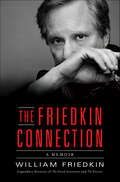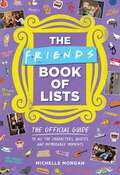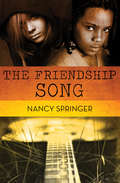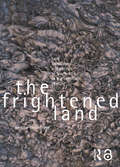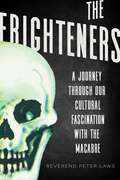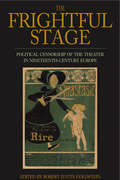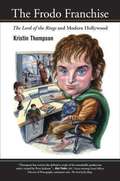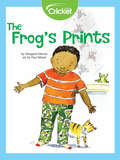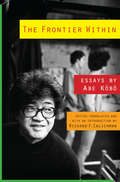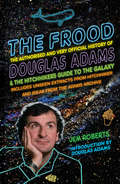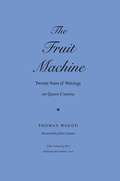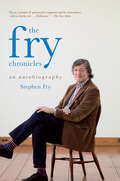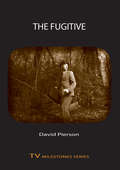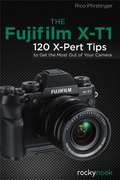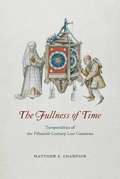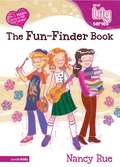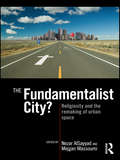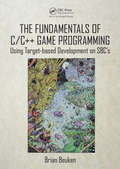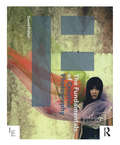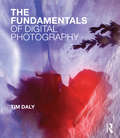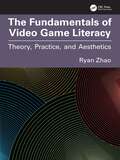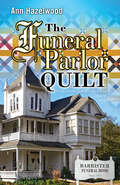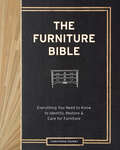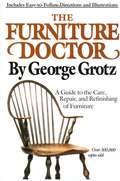- Table View
- List View
The Friedkin Connection: A Memoir
by William FriedkinAn acclaimed memoir from an American cinema maverick and Academy Award–winning director of such legendary films as The French Connection and The Exorcist.The Friedkin Connection takes readers from the streets of Chicago to the suites of Hollywood and from the sixties to today, with autobiographical storytelling as fast-paced and intense as any of the auteur’s films.Friedkin’s success story has the makings of classic American film. He was born in Chicago, the son of Russian immigrants. Immediately after high school, he found work in the mailroom of a local television station, and patiently worked his way into the directing booth during the heyday of live TV.An award-winning documentary brought him attention as a talented new filmmaker and an advocate for justice, and it caught the eye of producer David L. Wolper, who brought Friedkin to Los Angeles. There he moved from television to film, displaying a versatile stylistic range. In 1971, The French Connection was released and won five Academy Awards, including Best Picture and Best Director, and two years later The Exorcist received ten Oscar nominations and catapulted Friedkin’s career to stardom.Penned by the director himself, The Friedkin Connection takes readers on a journey through the numerous chance encounters and unplanned occurrences that led a young man from a poor urban neighborhood to success in one of the most competitive industries and art forms in the world. In this fascinating and candid story, he has much to say about the world of moviemaking and his place within it.“Friedkin’s against-all-odds success story is compelling reading from the start.” —LA Weekly
The Friends Book of Lists: The Official Guide to All the Characters, Quotes, and Memorable Moments
by Michelle MorganPacked with compelling facts and trivia from all ten seasons, The Friends Book of Lists breaks down the memorable series in a collection of 100+ easy-to-digest lists focusing on themes, characters, and favorite moments in an irresistible package. Each entry in this comprehensive book celebrates another corner of the Friends universe and offers new discoveries and facts concerning cherished characters and themes. From every time Joey says, &“How you doin&’?&” to memorable holiday episodes, each list will delight fans and remind them why Friends is one of the most beloved comedy series of all time. Lists include: Family Trees Chick and Duck Appearances Every Time Ross Says, &“We were on a break!&” Ugly Naked Guy&’s Activities Chandler&’s Top Four Reasons to Get Married Phoebe&’s Songs Imaginary Things on Joey&’s Resumé Ross&’s Spray Tan Disaster Janice&’s Appearances Guest Star Appearances And more! Including full-color photos and visuals throughout, The Friends Book of Lists is an officially licensed must-have collector's item for the ultimate Friends fan.
The Friendship Song
by Nancy SpringerWhen Harper and her dad move to a new house, a creepy stepmom is the least of her worries Harper is not too happy to be moving in with her soon-to-be stepmother, Gus. The eccentric woman&’s home, which the neighbors call the Spook House, has a yard full of weird metal sculptures. Gus is nothing like Harper&’s dad&’s other girlfriends, and Harper would take her former trailer home over the Spook House any day. Luckily, a girl named Rawnie lives right across the street. Harper and Rawnie have lots in common, including the same favorite band: Neon Shadow. When the girls start hearing mysterious rock music coming from Gus&’s yard, they get suspicious. Then something terrible happens at a Neon Shadow concert, and Harper and Rawnie have no doubt that there are dark forces at work . . . and that Gus is involved. With their favorite singer in danger, they just might be the only two who can save him.
The Friendship Song
by Nancy SpringerWhen Harper and her dad move to a new house, a creepy stepmom is the least of her worries Harper is not too happy to be moving in with her soon-to-be stepmother, Gus. The eccentric woman&’s home, which the neighbors call the Spook House, has a yard full of weird metal sculptures. Gus is nothing like Harper&’s dad&’s other girlfriends, and Harper would take her former trailer home over the Spook House any day. Luckily, a girl named Rawnie lives right across the street. Harper and Rawnie have lots in common, including the same favorite band: Neon Shadow. When the girls start hearing mysterious rock music coming from Gus&’s yard, they get suspicious. Then something terrible happens at a Neon Shadow concert, and Harper and Rawnie have no doubt that there are dark forces at work . . . and that Gus is involved. With their favorite singer in danger, they just might be the only two who can save him.
The Frightened Land: Land, Landscape and Politics in South Africa in the Twentieth Century
by Jennifer BeningfieldAn investigation into the spatial politics of separation and division in South Africa, principally during the apartheid years, and the effects of these physical and conceptual barriers on the land. In contrast to the weight of literature focusing on post-apartheid South Africa, the focus of this book includes the spatial, political and cultural landscape practices of the apartheid government and also refers to contemporary work done in Australia, England and the US. It probes the uncertainty and ambiguity of identities and cultures in post-apartheid society in order to gain a deep understanding of the history that individuals and society now confront. Drawing on a wealth of research materials including literature, maps, newspapers, monuments, architectural drawings, government legislation, tourist brochures, political writing and oral histories, this book is well illustrated throughout and is a unique commentary on the spatial politics of a time of enormous change.
The Frighteners: A Celebration of our Fascination with the Macabre
by Peter LawsThe Frighteners is a bizarrely compelling, laugh-out-loud exploration of societies’ fascination with the dark, spooky, and downright terrifying side of life. The author--self proclaimed “sinister minister”--opens the book by reflecting on how he went from a horror-obsessed atheist to a God-fearing Christian and then reconciled his love of the macabre with his new faith. In the chapters that follow, Laws takes us on a worldwide romp to shine light on the dark corners of our own minds. An American hell house--controversial Christian “haunted houses” that act out the horrors of abortion, drug use, etc.—hosts his reflection on the use of horror in religion. A party in London with real life “vampires” exemplifies modern sexual fascination with the parasitic undead. He goes ghost hunting in an underground barbershop where a murderer used to cut hair. A professor in Denmark who is an expert on the recent Slenderman court case helps him explore the link between technology and the supernatural. In accessible and light-hearted prose, Peter Laws takes us from the dark corners of his mind to the underbelly of various macabre cultures to illuminate society’s preoccupation with death and horror. The Frighteners combines psychology, religious theory, and personal memoir to create a dynamic and fascinating read that is informative and entertaining.
The Frightful Stage
by Robert Justin GoldsteinIn nineteenth-century Europe the ruling elites viewed the theater as a form of communication which had enormous importance. The theater provided the most significant form of mass entertainment and was the only arena aside from the church in which regular mass gatherings were possible. Therefore, drama censorship occupied a great deal of the ruling class's time and energy, with a particularly focus on proposed scripts that potentially threatened the existing political, legal, and social order. This volume provides the first comprehensive examination of nineteenth-century political theater censorship at a time, in the aftermath of the French Revolution, when the European population was becoming increasingly politically active.
The Frodo Franchise: The Lord of the Rings and Modern Hollywood
by Kristin ThompsonKristin Thompson interviewed seventy-six people to examine the movie's scripting and design and the new technologies deployed to produce the films, videogames, and DVDs. She demonstrates the impact Rings had on the companies that made it, on the fantasy genre, on New Zealand, and on independent cinema.
The Frog's Prints
by Margaret MincksJackson wants to learn to make pajama pants for his tree frog friend, Fred. With the help of his mother, he creates tiny pajama pants for Fred that match his own.
The Frontier Within: Essays by Abe Kobo (Weatherhead Books on Asia)
by Kōbō AbeAbe Kobo (1924–1993) was one of Japan's greatest postwar writers, widely recognized for his imaginative science fiction and plays of the absurd. However, he also wrote theoretical criticism for which he is lesser known, merging literary, historical, and philosophical perspectives into keen reflections on the nature of creativity, the evolution of the human species, and an impressive range of other subjects. Abe Kobo tackled contemporary social issues and literary theory with the depth and facility of a visionary thinker. Featuring twelve essays from his prolific career—including "Poetry and Poets (Consciousness and the Unconscious)," written in 1944, and "The Frontier Within, Part II," written in 1969—this anthology introduces English-speaking readers to Abe Kobo as critic and intellectual for the first time. Demonstrating the importance of his theoretical work to a broader understanding of his fiction—and a richer portrait of Japan's postwar imagination—Richard F. Calichman provides an incisive introduction to Abe Kobo's achievements and situates his essays historically and intellectually.
The Frood: The Authorised and Very Official History of Douglas Adams & The Hitchhiker’s Guide to the Galaxy
by Jem RobertsAs a wise ape once observed, space is big – vastly, hugely, mind-bogglingly so. However, if you look too closely at space, it becomes nothing but lumps of rock and sundry gases. Sometimes it's necessary to take a step back, and let a few billion years go by, before any of the true wonder and scope of the cosmos becomes apparent. Similarly, the late 20th century author, humorist and thinker Douglas Adams was big – vastly, hugely and thoroughly mind-bogglingly so, both in physical terms, and as a writer who has touched millions of readers, firing up millions of cerebellums all over planet Earth, for over 35 years – and for nearly half of that time, he hasn't even been alive. It would be ridiculous to pretend that Douglas Adams's life and work has gone unexamined since his dismayingly early death at 49 but throughout the decade since the last book to tackle the subject, the universes Adams created have continued to develop, to beguile and expand minds, and will undoubtedly do so for generations to come. An all-new approach to the most celebrated creation of Douglas Adams is therefore most welcome, and The Frood tells the story of Adams's explosive but agonizingly constructed fictional universe, from his initial inspirations to the posthumous sequel(s) and adaptations, bringing together a thousand tales of life as part of the British Comedy movements of the late 70s and 80s along the way. With the benefit of hindsight and much time passed, friends and colleagues have been interviewed for a fresh take on the man and his works.
The Fruit Machine: Twenty Years of Writings on Queer Cinema
by Thomas Waugh John GreysonFor more than twenty years, film critic, teacher, activist, and fan Thomas Waugh has been writing about queer movies. As a member of the Jump Cut collective and contributor to the Toronto-based gay newspaper the Body Politic, he emerged in the late 1970s as a pioneer in gay film theory and criticism, and over the next two decades solidified his reputation as one of the most important and influential gay film critics. The Fruit Machine--a collection of Waugh's reviews and articles originally published in gay community tabloids, academic journals, and anthologies--charts the emergence and maturation of Waugh's critical sensibilities while lending an important historical perspective to the growth of film theory and criticism as well as queer moviemaking. In this wide-ranging anthology Waugh touches on some of the great films of the gay canon, from Taxi zum Klo to Kiss of the Spider Woman. He also discusses obscure guilty pleasures like Born a Man . . . Let Me Die a Woman, unexpectedly rich movies like Porky's and Caligula, filmmakers such as Fassbinder and Eisenstein, and film personalities from Montgomery Clift to Patty Duke. Emerging from the gay liberation movement of the 1970s, Waugh traverses crises from censorship to AIDS, tackling mainstream potboilers along with art movies, documentaries, and avant-garde erotic videos. In these personal perspectives on the evolving cinematic landscape, his words oscillate from anger and passion to wry wit and irony. With fifty-nine rare film stills and personal photographs and an introduction by celebrated gay filmmaker John Greyson, this volume demonstrates that the movie camera has been the fruit machine par excellence.
The Fry Chronicles: An Autobiography
by Stephen FryThe British actor, writer, and comedy legend tells his story: “Funny, poignant . . . His prose feels like an ideal form of conversation.” —The Washington PostA #1 Sunday Times BestsellerWhen Stephen Fry arrived at Cambridge, he was a convicted thief, an addict, and a failed suicide, convinced that he would be expelled. Instead, university life offered him love and the chance to entertain. He befriended bright young things like Hugh Laurie and Emma Thompson, and delighted audiences with Blackadder and A Bit of Fry and Laurie. Covering most of his twenties, this is the riotous and utterly compelling story of how the Stephen the world knows (or thinks it knows) took his first steps in theater, radio, television, and film. Tales of scandal and champagne jostle with insights into hard-earned stardom. The Fry Chronicles is not afraid to confront the chasm that separates public image from private feeling, and it is marvelously rich in trademark wit and verbal brilliance.“Charming.” —The Wall Street Journal“Genuinely touching and often hilarious.” —Publishers Weekly
The Fugitive
by David PiersonA social, cultural, historical, and institutional analysis of the classic original series The Fugitive.
The Fujifilm X-E2
by Rico PfirstingerThe Fujifilm X-E2: Beyond the Manual provides experience-based information and insights for owners of the Fujifilm X-E2 mirrorless system camera. Fuji X-Pert series author Rico Pfirstinger teaches little-known capabilities of the X-E2 that he's discovered through several months of in-depth research. This book focuses on insights that you won't find in the manual, skipping tedious explanations of basic camera functions and operations. Instead, it cuts to the chase and provides readers with a plethora of tips and practical instructions that will enable them to fully explore the capabilities of the X-E2.The X-E2 combines classic design with state-of-the-art digital camera technology originally seen in the X-Pro1 and X-E1 system cameras. These features have been further improved to achieve the X-E2: Fujifilm's most capable camera to-date, with an ever-growing set of already more than ten interchangeable X-Mount lenses. The Fujifilm X-E2: Beyond the Manual presents numerous tips and tricks that will maximize your ability to use the Fujifilm X-E2 to its full potential.
The Fullness of Time: Temporalities of the Fifteenth-Century Low Countries
by Matthew S. ChampionThe Low Countries were at the heart of innovation in Europe in the fifteenth century. Throughout this period, the flourishing cultures of the Low Countries were also wrestling with time itself. The Fullness of Time explores that struggle, and the changing conceptions of temporality that it represented and embodied showing how they continue to influence historical narratives about the emergence of modernity today. The Fullness of Time asks how the passage of time in the Low Countries was ordered by the rhythms of human action, from the musical life of a cathedral to the measurement of time by clocks and calendars, the work habits of a guildsman to the devotional practices of the laity and religious orders. Through a series of transdisciplinary case studies, it explores the multiple ways that objects, texts and music might themselves be said to engage with, imply, and unsettle time, shaping and forming the lives of the inhabitants of the fifteenth-century Low Countries. Champion reframes the ways historians have traditionally told the history of time, allowing us for the first time to understand the rich and varied interplay of temporalities in the period.
The Fun-Finder Book: It's a God Thing!
by Nancy RueKids are invited to discover their God-given talents with this guide to hobbies. Includes a self-quiz to help readers recognize their likes and dislikes.
The Fundamentalist City?: Religiosity and the Remaking of Urban Space
by Nezar AlSayyadThe relationship between urbanism and fundamentalism is a very complex one. This book explores how the dynamics of different forms of religious fundamentalisms are produced, represented, and practiced in the city. It attempts to establish a relationship between two important phenomena: the historic transition of the majority of the world’s population from a rural to an urban existence; and the robust resurgence of religion as a major force in the shaping of contemporary life in many parts of the world. Employing a transnational interrogation anchored in specific geographic regions, the contributors to this volume explore the intellectual and practical challenges posed by fundamentalist groups, movements, and organizations. They focus on how certain ultra religious practices of Christianity, Hinduism, Islam, and Judaism have contributed to the remaking of global urban space. Their work suggests that it is a grave oversimplification to view religious orthodoxies or doctrines as the main cause of urban terrorism or violence. Instead they argue that such phenomena should be understood as a particular manifestation of modernity’s struggles. Nezar AlSayyad and Mejgan Massoumi’s book provides fascinating reading for those interested in religion and the city, with thought provoking pieces from experts in anthropology, geography sociology, religious studies, and urban studies.
The Fundamentals of C/C++ Game Programming: Using Target-based Development on SBC's
by Brian BeukenThis book is aimed at giving novice coders an understanding of the methods and techniques used in professional games development. Designed to help develop and strengthen problem solving and basic C/C++ skills, it also will help to develop familiarity targeting and using fixed/restricted hardware, which are key skills in console development. It allows the reader to increase their confidence as game programmers by walking them through increasingly involved game concepts, while maintaining the understanding that despite the increased complexity, the core methods remain consistent with the advancement of the technology; the technology only enhances the gaming experience. It also demonstrates underlying principles of game coding in practical step by step ways to increase exposure and confidence in game coding concepts. Key Features: Increases the confidence of new coders by demonstrating how to get things done. Introduces evolving projects to reinforce concepts, both directly and indirectly that the reader will use to produce and then enhance the project. Provides tutorials on Graphics API’s that can be easily understood by a novice. Demystifies hardware used to gain new effects without blinding the user to the technical wizardry going on under the system. Gives a sense of achievement to the reader and pushes them toward improvement.
The Fundamentals of Creative Photography
by David PrakelThe Fundamentals of Creative Photography offers a comprehensive introduction to the world of applied creative photography. It is concerned with photography in a professional context – images that are to be used in the fulfilment of a brief, rather than those created solely for self-expression. Creativity is important, but must be focused on meeting the client’s needs.The book explores the principles that underpin the discipline, guiding the reader though the practical considerations involved in executing the perfect shot. It includes guidance on acquiring and developing new skills, the practice of self-promotion and self-administration, and a discussion of the image workflow.
The Fundamentals of Digital Photography (Fundamentals Ser.)
by Tim DalyThe Fundamentals of Digital Photography explores the guiding principles of great photography through efficient and effective technique. Easy-to-follow instructions teach you how to work with a digital workflow and develop a solid understanding of materials and processes. You will also find creative inspiration through the work of some of the world’s great historical photographers, and discover how the history of photography can feed into your own work. Themed projects, featuring stunning images from contemporary international practitioners, will help you focus your ideas to produce truly original photographs.The assignments at the end of each chapter help you to create a body of work that will expand your photographic portfolio. By shooting these carefully devised assignments, you will become a confident software user, and develop the all-important visual and conceptual skills essential to successful photography.
The Fundamentals of Video Game Literacy: Theory, Practice, and Aesthetics
by Ryan ZhaoThis book posits a novel framework for sense‑making and meaning‑making in the play of video games. Extending a modern, process‑oriented, audience‑inclusive philosophy of artistic meaning generation, this book grapples with the question of how to personally and critically examine video games as artistic artifacts that do not have set, predetermined, standardized forms until live play is enacted. The resulting artistic product, live gameplay, expresses both the game’s developers and its players.This book argues that players hold three separate, concurrent perspectives during play: the embodied avatar within the simulated space, the role‑playing participant in the narrative fantasy, and the external strategist manipulating the game’s software affordances. The exciting dynamics that arise from live gameplay are the result of the tensions and harmonies between these three parallel layers of play.Video games are systems with designed behaviors capable of a great diversity of instantiated expressions. Players are brought into that system of instantiated generation to produce truly emergent and personal gameplay. As such, players directly impact the shape and form of the gameplay artifact itself. This creates a relationship between the art, the player, and its meaning radically different from all previous art forms.This book builds around this central premise with examinations of related subjects pertaining to video game meaning‑making, such as the ways in which video games facilitate play that is expressive of their players and the ways in which it is appropriate to compare and contextualize the differences in players’ instantiated play activities. These subjects are designed to give readers an in‑depth understanding of the dynamics of gameplay in order to facilitate richer, more meaningful encounters with video games as cultural artifacts.This book: Provides a useful framework for enriching players’ experiences with video game play. Helps players identify and distinguish aspects of their own and game developers’ expression in gameplay. Posits a novel framework examining the role of player as embodied avatar, role‑player, and strategist. Gives players appropriate questions to better interrogate the generation of meaning from within and surrounding the system of gameplay.
The Funeral Parlor Quilt (Colebridge Community Series)
by Ann HazelwoodAfter quitting her boring editing job, aspiring writer Lily Rosenthal isn't sure what to do next. Her only joys in life are collecting antique quilts and frequenting the area's beautiful wine country. The murder of a friend results in her inheriting the inventory of a local antique store. She begins to consider opening her own shop, even though this will mean uprooting her life. With some help from her sisters, a ghost, and a handsome baseball fan, Lily embarks on a journey filled with laughs, loss, and red-and-white quilts.
The Furniture Bible: Everything You Need to Know to Identify, Restore & Care for Furniture
by Martha Stewart Jen Renzi Christophe PournyChristophe Pourny learned the art of furniture restoration in his father’s atelier in the South of France. In this, his first book, he teaches readers everything they need to know about the provenance and history of furniture, as well as how to restore, update, and care for their furniture—from antiques to midcentury pieces, family heirlooms or funky flea-market finds. The heart of the book is an overview of Pourny’s favorite techniques—ceruse, vernis anglais,and water gilding, among many others—with full-color step-by-step photographs to ensure that readers can easily replicate each refinishing technique at home. Pourny brings these techniques to life with a chapter devoted to real-world refinishing projects, from a veneered table to an ebonized desk, a gilt frame to a painted northern European hutch. Rounding out this comprehensive guide is care and maintenance information, including how to properly clean leather, polish hardware, fix a broken leg, and replace felt pads, as well as recipes to make your own wax, shellac, varnish, stain, and more.
The Furniture Doctor: A Guide to the Care, Repair, and Refinishing of Furniture
by George GrotzThe best-selling guide to keeping furniture in the finest and most beautiful condition, with complete information on proper repair and refinishing techniques from the legendary expert on antiques and their restoration.B & W photographs throughoutFrom the Trade Paperback edition.
